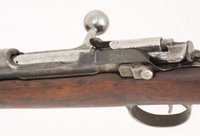By this time, Mannlicher had a new protege, and Steyr a rising star, in the form of a fortysomething engineer by the name of Otto Schoenauer. He set about making various refinements to the Gew.88 and, when the older rifle began losing ground to Paul Mauser's newer charger-loaded designs, fitted his modified version of the Commission Rifle with a slick new development: A rotary magazine. This magazine had a rotating spindle in it, notched to hold the bullets, and would feed cartidges very smoothly, as it minimized the friction of the cartridges rubbing against one another in the magazine, unlike the staggered box designs common on other rifles of the day. Packaging his new magazine in his latest upgraded rifle, he began shopping it around Europe.

Above: Greek M1903/14 Mannlicher-Schoenauer, Photo by Oleg Volk
The rotary magazine could be charged with a stripper clip like a Mauser, but could be safely unloaded through the ejection port with the press of a button unlike Mauser designs, which needed the magazine floorplate to be hinged down or removed for safe unloading. The rifle itself was slim and graceful, weighing in at only 8.25 pounds even in the full 48" long infantry version.

Left: The rotary magazine, viewed from above. The button on the right-hand receiver wall releases the magazine's contents. Photo by Oleg Volk.
The action was ultra-slick, with a full-length guide rib, and had several safety and reliability tweaks over the Commission rifle, but this didn't help sales. Fearing complications caused by the slightly Rube Goldberg-esque magazine, armies stayed away from the new design in droves, and Schoenauer's baby was flattened by the Mauser juggernaut on the world market.
In the end, the only nation that bought the rifle was Greece, who, in a bizarre twist of fate, found themselves on the wrong side of the trenches from their main rifle supplier when World War One broke out. By the end of that conflict, Greece was badly short on Mannlicher-Schoenauers, and was making up their losses with captured Austro-Hungarian Steyr-Mannlichers and hand-me-downs from their allies. After the war they needed more rifles, but Steyr was located in the new nation of Austria and, as part of the losing side, couldn't sell military arms on the world market under the terms of the Treaty of Versailles. Relief was to be had in 1926 when Breda, in Italy, was contracted to supply M/S 1903/14 rifles and carbines. The Greeks eventually phased the rifle out of frontline service, replacing it with Mausers, and later, as a part of NATO, with British and American arms. Rumor has it, incidentally, that the Breda contract rifles were actually merely assembled and marked there, and had actually been manufactured at Steyr.

Right: Gew.88-derived action. Used in Greece. Marked in Italy. Made in Austria? Photo by Oleg Volk.
So as a military rifle the Mannlicher-Schoenauer was a flop, but its smoothness made it a very popular sporting rifle. It was successfully marketed and sold as such from 1903 into the 1950's, pretty much unchanged. One reason that original military models are so scarce on the collector's scene today is that most all of them were turned into sporters after they appeared on the surplus market.
Oh, and about that fragile rotary magazine that militaries of the day didn't like? Maybe it's not so bad; it hasn't stopped Ruger from selling a blue million 10/22's...

No comments:
Post a Comment